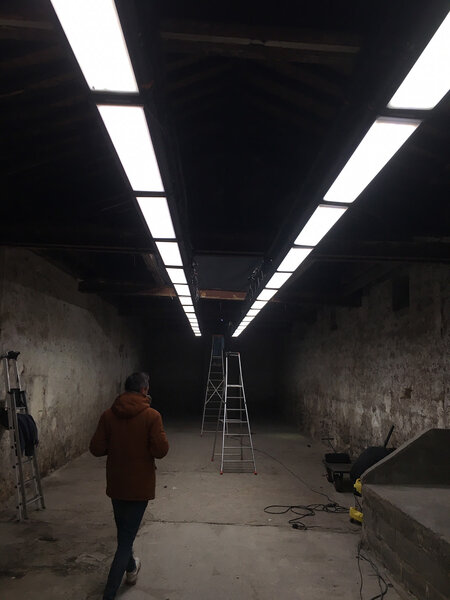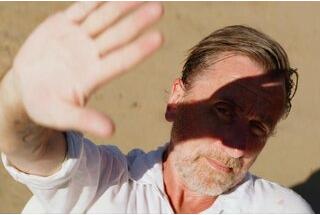80th Venice Film Festival
Inès Tabarin, AFC, discusses her cinematographic choices on Alix Delaporte’s "Vivants"
"The Capa Family", by François Reumont for the AFCGabrielle has just joined a prestigious news program. Because of her atypical educational background, she must overcome prejudice in order to prove herself to a team of experienced journalists. Immersed in their world, she gradually pierces the mystery of these great reporters, always passionate, often funny, sometimes wounded by life and their profession. Then there is Vincent, the editor in chief of the program, who she is constantly upsetting…
Shot over a six-week period in the Paris region, Vivants, by Alix Delaporte, plunges viewers into the exciting life of journalist television reporters. An insider’s view into a newsroom that, until recently, had enjoyed great prestige, but which is currently in trouble, and whose members form a sort of family with whom they share their successes and failures. Inès Tabarin details the challenges on this film produced by Alain Attal.
“Alix wanted to portray the ambience of the newsrooms she worked in at the start of her career. Gabrielle’s trajectory was inspired by her own experience at the time. When I arrived on the film, I immediately proposed American references where the office (The Office) is a key element. Like in Alan Pakula’s All the President’s Men, his “Spielbergian” suite Pentagon Papers or Bennett Miller’s Moneyball. Alix also mentioned Spotlight, which provided us a lot of inspiration for how to film the characters together. Another film that guided me for the lighting was Steven Soderbergh’s Erin Brockovich, shot by Ed Lachman. The idea was to have warm interiors to make the press agency feel immediately familiar. The film was mainly set there, so it became one of the main challenges on the film for me. This is a false-choral film with a multitude of characters. The set brings them all together without any intimate vignettes outside of the newsroom.”
Once the decision was made to build the set on the 9th floor of a former parking garage, the cinematographer and the director engaged in a meticulous preparation on set. “We spent two weeks before shooting on set, the two of us rehearsing each scene and determining the way the characters would move around, based on their various psychologies and situations. It was a way of bringing the space to life and inhabiting it. One of the advantages of this set used for most of the film (both the agency and the scene in the Central African Republic and the scene with the Vegan commando) was that we could shoot the film mostly in chronological order and thereby have a certain amount of flexibility with our shooting schedule.”
Another mission before shooting began was to spend a night with a real ambulance driver in order to bring Gabrielle’s first reporting mission to life : “Alix wanted a lot of realism, and to live within the shooting conditions reporters face as much as possible, and the idea of us going to shadow an ambulance driver from the Parisian hospital of Pitié Salpêtrière really did help me to acquire the reflexes of a camera reporter. I had a simple Sony FX6 and all of the issues that one must face with this type of reporting quickly cropped up. The distance with the characters, the way of filming… all of these things were useful to me for the rest of the film.
As for the way that we covered some of the group scenes in the newsroom, the option of using two cameras was discussed in preparation — simply in order to bring as much material as possible to the cutting room and to provide the best flow possible to all of the scenes with a lot of characters in the newsroom. But after our two weeks of preparation, Alix and I decided to stick with a single camera, so that we could remain as concentrated as possible on each character, even if that meant some scenes would necessarily take longer to film.”
Then, to get into the heart of the story, the cinematographer and the director sought out together the right visual combination for the film : “I must have tried out almost all of the lenses at Transpacam,” explains Inès Tabarin. “Franck Graumann helped me a lot during this phase so that Alix and I could come to a decision.”
Retaining the 2.35 format used on All the President’s Men and Klute, they finally decided on the Atlas Orion anamorphic series. “We really fell in love with these lenses,” explains Inès. “They are reliable in their build quality and their mechanics, but they don’t have the overly-clean look of modern anamorphic lenses. They are malleable, becasue they are very rigorous from f4, but then they have more personality at full aperture (f2). Then, they make you think of Hawk V-Lites with aberrations at the top and bottom. The 80mm lens was very useful to me on this film as it is an extraordinary focal length for isolating the characters from the space. The backgrounds really become like paintings… As for the shooting script, we agreed that we would often film with a shoulder camera, trying to keep a wide focus on Gabrielle (32 or 40mm) while the other characters would be filmed with longer focal lengths. Especially Vincent Elbaz’s character, who had a lot of closeups and then left the group, and whom we needed to clearly identify before his departure for Bangui. It was a visual grammar that helped us to impart rhythm to each scene in the newsroom in order to avoid the monotonous side of the single location.”
For some less-narrative scenes that showed the characters’ interiority, Inès Tabarin also chose to use the zoom lens : “I love the Cooke 25-250mm Mark II zoom lens. I decided to use it for a couple zoom movements on some scenes, such as when Gabrielle discovers the dailies in the editing room, or in the dreamlike scene of Ravel’s Boléro. There, the blackness and the medium lights blend into one another, which serves to mark the intermediate nature that characterizes these unique moments in the film.”
In terms of lighting, it was important to the cinematographer to create variety : “For me, this office was supposed to feel like a home. Bringing subtle variations to the lighting to bring to life the family ambience. Firstly, chief decorator Nicolas de Boiscuillé and I worked on the color of the walls to make them ever so slightly blue with slightly yellow shutters for complementarity and to bring a bit of warmth to the Parisian winter. Then, we always had primary colors in the frame via costumes or props so that the space would never become boring. With the lighting, I thought that it was important to mark the passage of time… or at least mark the various zones of the newsroom, with its public space and the offices which were more private.
Technically, as the set had been built on a high floor, I didn’t have the possibility of lighting the outside. Etienne Lesur, my gaffer, and I decided to use LiteMats to replace the ceiling lights almost everywhere in the agency. They were controllable by WiFi and could be framed. But we quickly found ourselves confronted with their lack of availability.

To compensate, he installed DMG SL1s in the drop ceiling by distancing them from the plexiglass plates used for diffusion that were also installed in the ceiling. This was done to avoid any hotspots. This emergency solution actually worked out quite well because the softness of the top light was actually more retro in its appearance, more 1970s-80s, since the lighting looked like neons. A lot of prop lights were included at various locations, and they allowed me to create a more intimate feeling depending on the scene, and to play with warmer color temperatures in our characters’ newsroom. In the main, the actors were lit by the top light setup, with occasional additions from the ground. There were almost no traditional lights on stands on this set which had been built like a natural interior.”
(Interview by François Reumont for the AFC, and translated from French by A. Baron-Raiffe)
Vivants
Directed by : Alix Delaporte
Cinematography : Inès Tabarin, AFC
Set Design : Nicolas de Boiscuillé, ADC
Costume Design : Caroline Spieth
Sound : Pierre Tucat, Arnaud Rolland, Eric Tisserand, AFSI
Editing : Virginie Bruant
Music : Evgueni & Sacha Galperine
 En
En Fr
Fr





